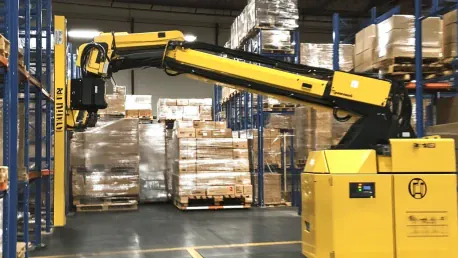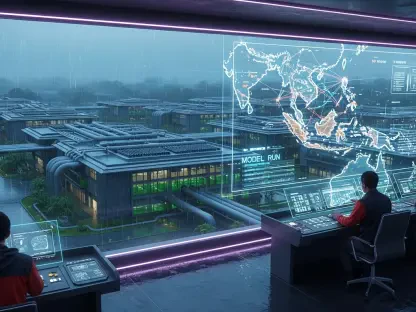Lab0 has recently unveiled RoboGlide, an AI-powered robotics system designed to transform inbound logistics and warehouse operations. With over two years of development and a debut in a live setting at a major retailer, RoboGlide is poised to address significant challenges in the logistics industry, including labor shortages and rising costs. This article explores the unique features, capabilities, and potential impact of RoboGlide on warehouse automation and supply chains.
Introducing RoboGlide: A New Era in Warehouse Automation
A Comprehensive and Integrated System
RoboGlide stands out from other robotic solutions by offering a fully integrated system that combines artificial intelligence, computer vision, motion planning, and advanced robotics. This cohesive package makes it uniquely capable of automating critical stages of warehouse operations, including unloading shipping containers, product identification, damage detection, sorting, palletizing, and wrapping. Existing systems often rely on off-the-shelf technology with limited capabilities for customization and integration. In contrast, RoboGlide’s seamless integration ensures that various operational stages are optimized simultaneously, significantly enhancing overall efficiency.
The combination of artificial intelligence and computer vision allows RoboGlide to perform complex tasks like product identification and damage detection with high accuracy. Motion planning algorithms enable it to navigate and interact with the warehouse environment dynamically. This integrated approach addresses the multifaceted challenges of warehousing, providing a robust solution that tackles a broad range of logistics tasks. By reducing the reliance on manual labor and minimizing error rates, RoboGlide represents a substantial leap forward in the automation of warehouse operations.
The Dual-Arm Advantage
One of the key features that sets RoboGlide apart is its dual-arm picking system, a first in the industry. This innovation allows RoboGlide to handle a broader range of products more efficiently and accurately than single-arm systems. Conventional robotic systems in logistics are generally limited to single-arm functionalities, which restrict their ability to manage diverse inventory types and complicate their ability to multitask. With a dual-arm system, RoboGlide brings a new level of flexibility, enabling it to pick and place items in a way that mirrors human dexterity.
This dual-arm capability is particularly beneficial in scenarios requiring high-speed sorting and handling of various products, where precision and adaptability are paramount. It enhances the robot’s capacity to work with diverse item shapes, sizes, and weights, ensuring that the system can manage different types of inventory more effectively. The technology’s scalability is also worth noting, as it allows RoboGlide to adapt to the growing demands of large-scale warehouse operations without significant adjustments to existing infrastructure, increasing its practicability for widespread adoption.
Real-World Application and Results
Operational Success at a Major Retailer
RoboGlide is not just a theoretical innovation; it is already operational in a live setting at one of the world’s top 10 importers. This significant endorsement underscores the system’s practical efficacy and its potential to bring substantial improvements in throughput and accuracy to real-world logistics operations. Early deployment results are promising, indicating significant gains in efficiency and accuracy within the retailer’s warehouse operations. These findings suggest that RoboGlide can indeed address some of the most pressing challenges in the logistics industry, such as labor shortages and process inefficiencies.
The success of RoboGlide in this live setting also demonstrates its ability to integrate seamlessly with existing systems while delivering tangible improvements. The major retailer’s initiative to employ RoboGlide as part of their operations speaks volumes about its confidence in the system’s capabilities. Not only does the system perform well under real-world conditions, but it also showcases the potential for broader application across various logistics networks, heralding a transformative effect on the industry as a whole.
Powered by NVIDIA’s Technology
At the core of RoboGlide’s advanced functionality is NVIDIA’s Isaac Lab and Omniverse platform. These tools support the system’s AI-driven vision and simulation capabilities, allowing RoboGlide to learn from real-world environments and adapt in real time. This technological backbone ensures that RoboGlide can handle various logistics tasks, including complex scenarios that require immediate and accurate responses. By leveraging NVIDIA’s powerful simulation platforms, RoboGlide can create and refine digital twins, enabling it to predict and mitigate potential operational issues before they arise.
Steve Toebes, CEO of Lab0, emphasized that this technology is designed for real-world challenges rather than controlled environments. This means that RoboGlide can process, sort, and detect damage seamlessly within dynamic and complex settings. The ability to adapt and learn from actual operational data is a significant advantage, ensuring that RoboGlide maintains robust performance even as variables and conditions change. This adaptability paves the way for continuous improvement, positioning the system as a dynamic solution in the fast-paced world of logistics.
Addressing Industry Challenges
Tackling Labor Shortages and Rising Costs
Warehouse operations are currently grappling with labor shortages and rising costs, making automation an essential path forward. RoboGlide addresses these challenges by offering a scalable and efficient solution that does not require significant infrastructure modifications. Its ability to manage diverse product types and streamline multiple stages of warehouse operations makes it a valuable asset in the logistics industry. The dual-arm design not only enhances operational efficiency but also ensures that a broad range of inventory can be handled seamlessly.
Moreover, the rising costs associated with human labor and the limitations of the current workforce highlight the urgent need for sophisticated automation solutions. RoboGlide’s implementation can reduce labor dependency while simultaneously increasing throughput and minimizing errors, which translates to significant cost savings. These advantages not only make the system an attractive proposition for individual warehouses but also point toward a shift in the logistics landscape where comprehensive automation becomes the norm rather than the exception.
A Holistic Approach to Logistics
Lab0 differentiates itself by providing an end-to-end solution that addresses the entire inbound logistics process. Unlike point solutions that only tackle specific parts of the logistics chain, RoboGlide offers a comprehensive approach that optimizes multiple stages simultaneously. This integrated method ensures that the system adds significant value to overall warehouse operations. Lab0’s holistic strategy means that every aspect of inbound logistics—from unloading to palletizing—is streamlined within a unified system, reducing bottlenecks and improving overall flow.
This approach not only increases efficiency but also enhances reliability and predictability within warehouse operations. By automating entire processes rather than isolated tasks, RoboGlide ensures that all elements work in concert, thus maximizing productivity. This comprehensive solution underscores Lab0’s commitment to redefining logistics through a more cohesive and effective automation strategy. The company aims to tackle the inefficiencies that plague traditional systems, ensuring that their technology offers sustainable and long-term benefits.
The Future of Logistics with RoboGlide
Supply Chain Zero Initiative
Lab0 is not just focused on introducing advanced robotics; the company aims to transform the logistics industry through its “Supply Chain Zero” initiative. This initiative seeks to eliminate inefficiencies, waste, and redundancies within the supply chain using AI-powered automation and real-time analytics. Lab0’s commitment to leveraging sophisticated technology reflects its vision for a more efficient and streamlined logistics landscape. This ambition resonates with the broader industry objectives of minimizing environmental impact and increasing operational sustainability.
By implementing the Supply Chain Zero initiative, Lab0 endeavors to create a logistics environment where waste is minimized and efficiencies are maximized. The use of real-time analytics ensures that decisions can be data-driven, while AI-powered automation optimizes processes at every stage. This visionary approach not only aligns with modern sustainability goals but also ensures that logistics networks are more resilient and adaptive to market changes. It signals an evolving focus where technology plays a pivotal role in redefining traditional logistics frameworks.
Upcoming Innovations and Industry Impact
Lab0 recently introduced RoboGlide, an AI-powered robotics system aimed at revolutionizing inbound logistics and warehouse operations. After more than two years of development, RoboGlide made its debut in a live setting at a major retailer. This innovative system is equipped to tackle significant challenges in the logistics sector, such as labor shortages and escalating costs. The system’s advanced features and capabilities are designed to enhance warehouse automation and streamline supply chain processes. RoboGlide’s introduction is timely, as the logistics industry continues to face mounting pressures from various operational and economic factors. By potentially reducing the dependency on human labor and increasing efficiency, RoboGlide is set to make a substantial impact on how warehouses and supply chains function. This article delves into the unique functionalities RoboGlide offers, its potential benefits for businesses, and the broader implications it holds for the future of logistics and warehouse management.









